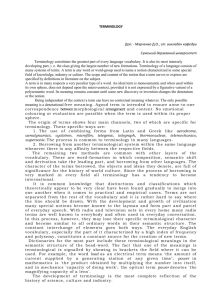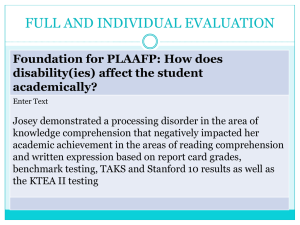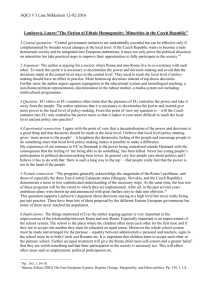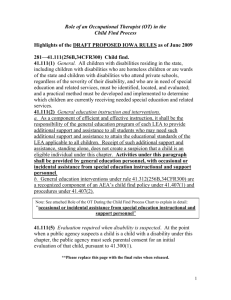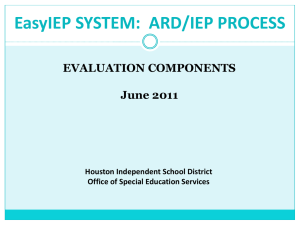Improving cognitive abilities in socially and culturally disadvantaged
advertisement
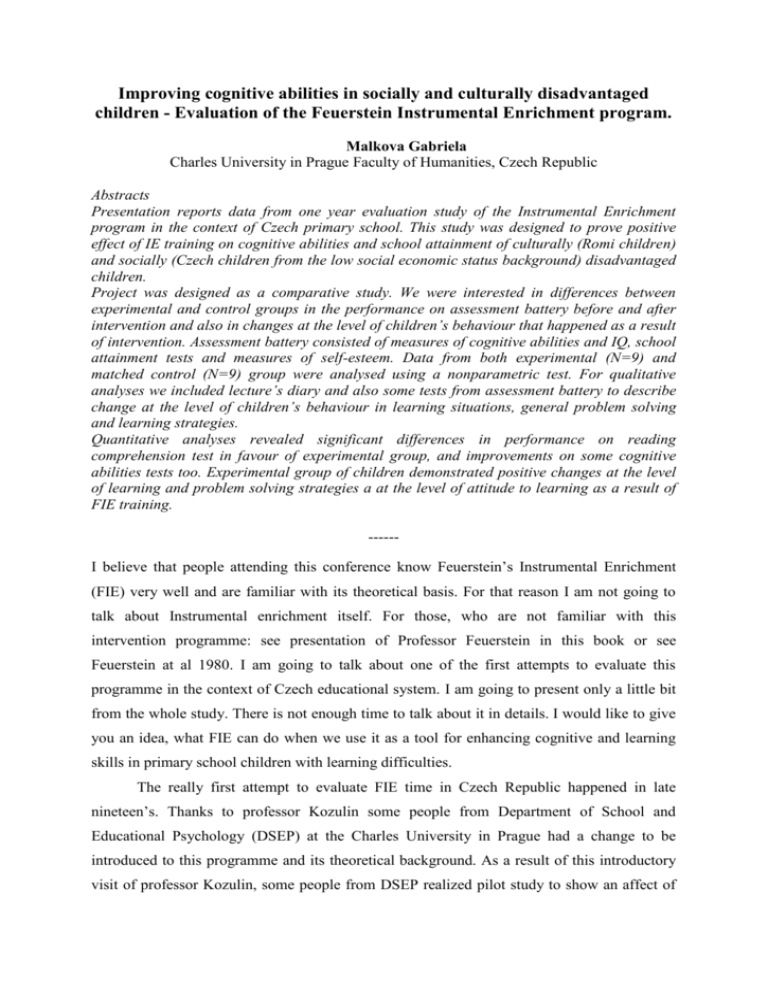
Improving cognitive abilities in socially and culturally disadvantaged children - Evaluation of the Feuerstein Instrumental Enrichment program. Malkova Gabriela Charles University in Prague Faculty of Humanities, Czech Republic Abstracts Presentation reports data from one year evaluation study of the Instrumental Enrichment program in the context of Czech primary school. This study was designed to prove positive effect of IE training on cognitive abilities and school attainment of culturally (Romi children) and socially (Czech children from the low social economic status background) disadvantaged children. Project was designed as a comparative study. We were interested in differences between experimental and control groups in the performance on assessment battery before and after intervention and also in changes at the level of children’s behaviour that happened as a result of intervention. Assessment battery consisted of measures of cognitive abilities and IQ, school attainment tests and measures of self-esteem. Data from both experimental (N=9) and matched control (N=9) group were analysed using a nonparametric test. For qualitative analyses we included lecture’s diary and also some tests from assessment battery to describe change at the level of children’s behaviour in learning situations, general problem solving and learning strategies. Quantitative analyses revealed significant differences in performance on reading comprehension test in favour of experimental group, and improvements on some cognitive abilities tests too. Experimental group of children demonstrated positive changes at the level of learning and problem solving strategies a at the level of attitude to learning as a result of FIE training. -----I believe that people attending this conference know Feuerstein’s Instrumental Enrichment (FIE) very well and are familiar with its theoretical basis. For that reason I am not going to talk about Instrumental enrichment itself. For those, who are not familiar with this intervention programme: see presentation of Professor Feuerstein in this book or see Feuerstein at al 1980. I am going to talk about one of the first attempts to evaluate this programme in the context of Czech educational system. I am going to present only a little bit from the whole study. There is not enough time to talk about it in details. I would like to give you an idea, what FIE can do when we use it as a tool for enhancing cognitive and learning skills in primary school children with learning difficulties. The really first attempt to evaluate FIE time in Czech Republic happened in late nineteen’s. Thanks to professor Kozulin some people from Department of School and Educational Psychology (DSEP) at the Charles University in Prague had a change to be introduced to this programme and its theoretical background. As a result of this introductory visit of professor Kozulin, some people from DSEP realized pilot study to show an affect of FIE as a tool for working with primary school children with learning disabilities (Pokorma, Hadj Moussova 1997). There were not many publications from this pilot study, as it suffered many methodological and organisational problems. However this study had one important effect: it made Dr. Pokorna impressed by FIE. Today, FIE exists, lives and is being inseminated in Czech Republic only thanks to this lady. The study I am going to report about started in 2001 and was a part of interdisciplinary. research project of Masaryk’s University in Brno and Charles university in Prague aimed at minorities and different cultures living in Czech republic (for more see Dalajka, Macek at al 2005). My contribution to this great project was to evaluate FIE as a tool for improving cognitive abilities in Roma children (the very common minority in Czech rep.) and in Czech children from low social economic status background. This project was designed as a one year evaluation study. It was realized at one school with approximately 20 kids and with 1 trainer, who worked with FIE to enriched cognitive abilities in children from “experimental” group. We deliberately chose this research design. Previous research projects realized in UK (for ex. Savell at al 1986, Burden 1987, Blagg 1991.) same as the first Czech pilot study with FIE had great difficulties to control a quality of mediated learning experience between lectures working with FIE. We also decided to work with such a small group of children, so that we could pay enough attention to the process in which they are getting familiar with FIE and change their cognitive abilities and thinking skills. Aim of this research was to: Evaluate FIE as an additional training to curriculum of socially and culturally disadvantaged pupils aged 9 -10 years (third and fourth grade) Research hypotheses 1. Experimental group of children will reveal significantly better results in chosen assessment battery as a result of implementation of FIE. 2. Experimental group of children will show positive changes at the level of their behaviour in situations of problem solving, and at the level of learning strategies and the process of getting familiar with given instrument (more effective strategies for solving problems, a skill to verbalize procedure for solving given tasks, a skill to plan how to solve given task…) Method For final analyses 18 children participated. At the beginning of our study, assessment of Roma and Czech children did not revealed any significant differences between Czech and Roma children within both research groups (experimental and control). Because of that: Experimental group consisted of 9 children (4 Roma, 5 Czech) Control group consisted of 9 children (4 Roma, 5 Czech) paired according to age, sex, and ethnicity. Tab No. 1 shows descriptive of age at the beginning of our study. Table 1 Descriptive statistics for age of children (experimental and control group) at the beginning of the study (in months). Group N Mean (SD) Range Experimental 9 115 (7,04) 101-121 Control 9 117,7 (7,42) 101-125 Children from experimental group were working with FIE during the period of 10 months, 3 hours per week within two working groups: Czech and Roma. Having these two working groups enabled us to look for and describe specificities or special needs of Roma children comparing to Czech ones when working with FIE (hypothesis No. 2). Total time for training with Roma group was 60 hours, 72 hours with group of Czech children. Children from our experimental group finished only one instrument: Organization of dots. We decided to evaluate given research hypotheses by using both qualitative and quantitative data analyses. For the first hypothesis, we were using quantitative analyses (nonparametric ManWhitney test) to show whether children from experimental group revealed significantly better results in assessment battery after one year of FIE training. Assessment battery consisted of: • Measures of IQ and cognitive abilities o TCF (Thorndike) – language, numeric, figural o Rey- Osterrieth Figure o Raven Coloured • School attainment tests o Reading fluency test o Numeric skills (adding and substraction) o Vocabulary in writing • Self confidence measures o SPAS (Boersma & Chapman) To evaluate second hypothesis, we were using qualitative analyses of Additional questions to Raven Couloured to find in what way children were thinking to solve particular task from the test The way children were drawing Rey Osterrieth figure Lecture’ s diary describing each training lesson, preparation for each lesson, discussions in lessons, children’s comments to the FIE material and the course of the training as a whole Results Table 2 shows performance on assessment battery for both research groups before intervention (T1) and after the intervention (T2) and p ( for Mann-Whitney) on tests from assessment battery after the intervention for experimental FIE group and control group. Children from experimental group after the 10 month training with FIE did comparing to control matched group of children significantly better in two tests: reading fluency test and in Rey- Osterrieth figure –copying. Improvement in reading fluency might be a result of the constant tendency of lecture to coax children to verbalize their thoughts and provoke discussions during FIE lessons. Copying Rey – Osterrieth’ s figure demands in children for example a skill to find a good strategy for drawing, a skill to plan drawing, to understand relationships between all the aspects of figure, have a good visual and memory skills to grasp all the details of figure … all these skills are trained when working with FIE. Table 2 Performance on assessment battery for both research groups before intervention (T1) and after the intervention (T2) and p ( for Mann-Whitney) on tests from assessment battery after the intervention for experimental FIE group and control group T1 mean (SD) T2 Mean (SD) p Exp. Con. Exp. Con. TCF* 169 (43.2) 186 (57.0) 233 (53.0) 257 (72.7) 0,41 Rey-Ost. -kopie** 56 (7.8) 56 (17.4) 63 (12.2) 57 (18.4) 0,05** Rey-Ost.- repro** 38 (9.8) 36 (10.8) 46 (11.3) 42 (18.5) 0,378 Raven Coloured 28 (5.3) 29 (5.4) 32 (4.7) 31 (6.2) 0,11 Reading comp. 83 (5.9) 91 (10.3) 88 (8.3) 90 (10.9) 0.01** Numeric 98 (5.7) 96 (9.2) 88 (8.3) 94 (7.1) 0,02 SPAS* 21 (6.3) 28 (8.6) 23 (7.9) 32 (6.1) 0,10 Vocabulary in writing 31 (16.6) 40 (17.7) 27 (9.7) 35 (13.1) 0,44 *raw scores ** significant in favour of FIE experimental group TCF / Test of cognitive functions (Thorndike); Rey-Osterrieth-c :Rey Osterrieth figure copy; Rey-Osterrieth-r :Rey Osterrieth figure reproduction; Reading comp.: reading comprehension test; Numeric: test of numerical skills, adding and subtraction; SPAS: Self confidence measure Qualitative analyses of additional questions for Raven Coloured enabled us to explain dramatically decreased number of mistakes experimental children did in this test after the intervention. All of them had (same as controls) ceiling effect. What has dramatically changed was the way in which children were explaining how they thought about the arguments for choosing particular matrices. These children were much better in identifying arguments for choosing matrices and in verbalizing their thinking when solving this task. Children were using more precise and accurate vocabulary to verbalize method for solving given task. In case of Rey - Osterrieth figure drawing, the most important is to mention, that children from experimental group completely changed strategies for drawing this figure. They gave up impulsive behaviour and replaced it by systematic and planned strategy for grasping and this figure. Lecture’s diary enabled us to identify differences in approach to instruments between Czech and Roma children. For example, for Roma children it meant 2 months more to establish learning style FIE uses: “bridging” and discussions about problems or interesting questions that happen in FIE lessons. Generally, Roma children had much more difficulties with an abstract character of instruments. For a first month it was hard for them to accept or understand a fact, that they are not doing math or Czech and that it can help them to be better in school. Results derived from quantitative analyzes would not probably be sufficient to accept firs hypotheses. From all the assessment battery, we can show significantly better performance of children from experimental group only in case of two tests. However, second hypothesis can be accepted as it is. Qualitative analyses enabled us to show, how dramatically FIE changes learning style, problem solving strategies, skills of verbalization and the whole attitude to learning in people who were introduced to its instruments. Discussion: There might of course be a question: Why is that so, that we are facing a situation of having clear proof of a change at the level of behaviour changes in learning and problem solving strategies and do not have a significantly better results in measurements of IQ, school attainment tests and test of self confidence? People who know FIE themselves would probably mention the question of a total time devoted to the intervention. 70 hours per one school year is not so much. On the other hand, this is probably maximum we can have if we want to implement FIE as an additional lesson to normal curriculum in primary school. It is said, that FIE works like snow ball: after a particular time spent on IE, people can become independent learners and can enhance their learning style and cognitive functions themselves. But for that they need to have already established prerequisites of learning. My suggestion would be to look for different distribution of FIE lessons during a school year. For example a one similar to that we offer in training courses for IE lectures. Maybe it would be much better to start with FIE in a very intensive training (one week only IE and no other subjects?), so that children can faster become familiar with FIE and could internalize the learning style this program uses. My feeling is that this intensive start would safe much time for other lessons where we can focus on cognitive deficits, improvement and enhancement of cognitive functions of children. Other lessons can be then distributed in a frequency of 3 hours per week. So probably the key for effective implementation of FIE is not a total time devoted to intervention, but the intensity of training at the beginning of implementation of program in school. References Blagg, N. (1991). Can we Teach Intelligence? Lawrence Erlbaum Associates, New Jersey 1991. Burden, R. (1987). Feuerstein’s Instrumental Enrichment Programme: Important Issues in Research Evaluation. European Journal of Psychology of Education, 2(1), str. 3-16. Dalajka, J., Macek, P., Eds. (2005):Vývoj a utváření osobosti v sociálních a etnických kontextech. Brno, Masarykova Universita. Feuerstein, R. Rand, Y., Hoffman, M B., Miller, R. (1980): Instrumental Enrichment. An Intervention Program for Cognitive Modifiability. Baltimore: University Park Press. Pokorna, V., Hadj-Moussova, Z. et al (1997): Evaluation of Instrumental Enrichment in Czech primary school; unpublished research report. Savell, J.M., Twohig, P. T., Rachford, D. L. (1986). Empirical Status of Feuerstein’s „Instrumental Enrichment” (FIE) Technique as a Method of Teaching Thinking Skills. Review of Educational Research, 56 (4), 381-409. malkova_gabriela@email.cz
![Name of the competition [“Global Cup”]](http://s3.studylib.net/store/data/007241658_1-7c34e3454a27e94ad31ac76b2636418b-300x300.png)
